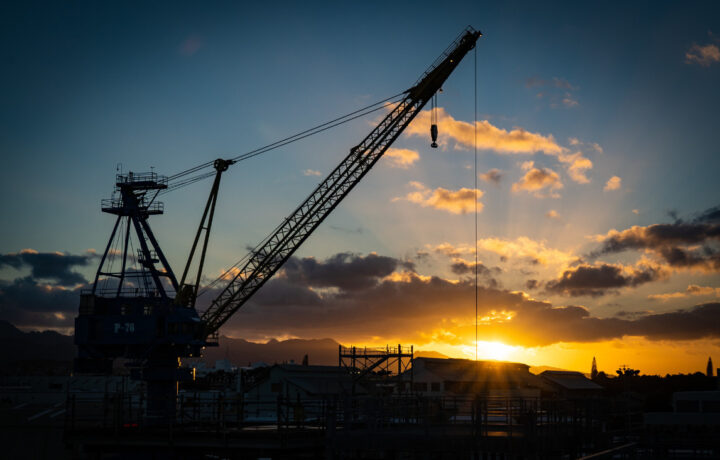It was a year ago that the Government Accountability Office (GAO) warned that greater shipyard capacity is needed for the United States Navy to ensure readiness for a potential conflict in the Indo-Pacific. The GAO’s report “Ongoing Challenges Could Jeopardize Navy’s Ability to Improve Shipyards” noted that the service has just four public shipyards that maintain its warships, yet, those facilities suffer from poor infrastructure conditions.
The current deficiencies at the shipyards had the potential to directly affect “the readiness of the aircraft carrier and submarine fleets” while the “conditions also affect the Navy’s ability to support the national defense.”
The U.S. Navy is currently struggling to achieve the 355 manned warships mandated by Congress, and a key issue is that the service lacks the facilities to build and maintain its fleet. Since the 1970s, 14 “defense-related shipyards” have been shuttered, while only one new shipyard has opened.
In addition, the number of firms still in the shipbuilding sector has dwindled.
This has only been worse by the fact that the shipbuilding industry is facing an ongoing challenge to attract, train and retain skilled labor. Just as the U.S. military has struggled to fill its ranks, the shipbuilding industry is facing a very serious labor shortage. There are not enough new workers to replace those who are retiring.
Foreign Shipyards to the Rescue?
The U.S. Navy could now be considering employing foreign shipyards to help address the issues with the domestic shipyards. Nikkei Business Daily reported on Wednesday that the U.S. embassy in Japan has informally approached the executives of Japanese shipbuilders, including Mitsubishi Heavy Industries and Kawasaki Heavy Industries.
U.S. Ambassador to Japan Rahm Emanuel is leading the efforts, and he has spoken to members of Congress, while embassy staff has been mobilized to reach out to Japanese officials.
Though this would be a considerable shift for the U.S. Navy, it could signal a new level of integration with U.S. allies and partners. The idea could further expand to South Korea, Singapore, and the Philippines.
Japan On Board
Although such a partnership to have U.S. vessels served in Japan and other foreign locations is still in the earliest stages, it isn’t actually a novel change of course. In the past, the U.S. Navy has employed shipyards in Japan, India, and the Philippines to repair logistics ships, including auxiliary vessels and replenishment oilers.
What is different now is that it would expand to warships, including destroyers, cruisers, and amphibious ships that are forward-deployed to Japan, a U.S. official told Nikkei.
This would also be a win for Japan, which was once one of the world’s most prominent shipbuilding nations, but recently lost market share to China and South Korea. As a result, Japanese shipyards have been forced to converge to save costs. A new flow of repair work from the U.S. Navy would be a boon for the Japanese shipyards.
In addition to those forward-deployed warships, other vessels that transit through the region could also have short-term maintenance handled in Japan and other foreign facilities. That could help reduce the burden on American shipyards and also save on the transit times back to the United States.
However, nuclear-powered warships – notably aircraft carriers and submarines – are not part of the consideration, even as one of the Navy’s nuclear-powered supercarriers is routinely forward-deployed to Japan.
Already, Japan-based warships are serviced on-site at U.S. naval bases in Yokosuka in Kanagawa prefecture and Sasebo in Nagasaki prefecture, using contract Japanese workers. However, in the case of multiyear overhauls, the Japan-based ships are assigned a home port shift back in the United States, while a replacement vessel is forward-deployed to Japan.
Greater Industrial Partnership
According to Nikkei, the U.S. has also expressed interest in exploring industrial partnerships between American and Japanese shipyards to expand capacity in both nations. Warships being serviced at off-base Japanese private shipyards could help spread the workload.
Currently, Japanese shipyards at Yokohama, Kanagawa prefecture, Maizuru, Kyoto prefecture, and Kure, Hiroshima prefecture, handle Japanese Maritime Self-Defense Force vessels.
“The ability of the United States Navy to be able to do forward-based repair and maintenance is critical,” said Navy Secretary Carlos Del Toro during a speech at the National Press Club in Washington in February.
Del Toro further noted the successful experience of repairing a U.S. Navy vessel in India last year, adding, “We’re also looking at other opportunities throughout Asia as well to where we might be able to do that as well to perhaps in the Philippines and Singapore and other places like that.”
Floating the Idea
Ambassador Emanuel first floated the idea of utilizing Japanese shipyard capacity in March during a seminar in Tokyo hosted by the Milken Institute.
“When I started in politics working for President [Bill] Clinton, there were 10 naval bases in the United States that built ships. Today there are six,” Emanuel told attendees. “Japan has a tremendous amount of naval capacity, of shipyard capacity. Japan’s industrial base can be a big part of this solution. And it’s going to be an important part of the United States [readiness] because to do what we have to do for our Navy, we cannot be limited to six shipyards.”
Emanuel further told Nikkei Asia that “Japan still has much to offer in shipyard maintenance.”




